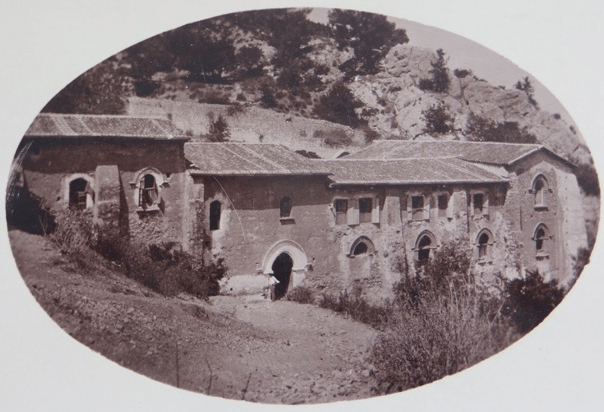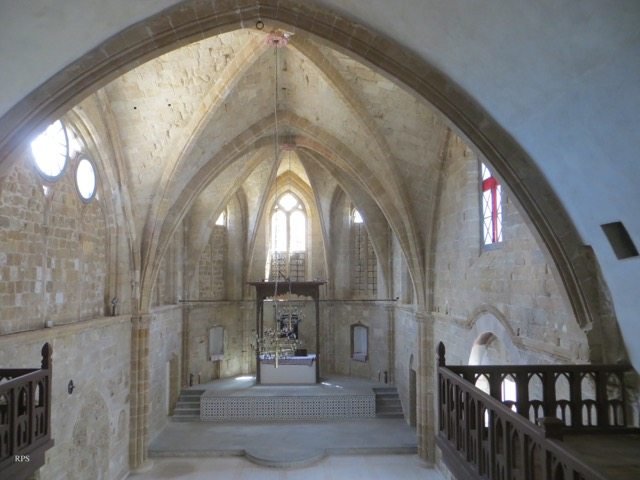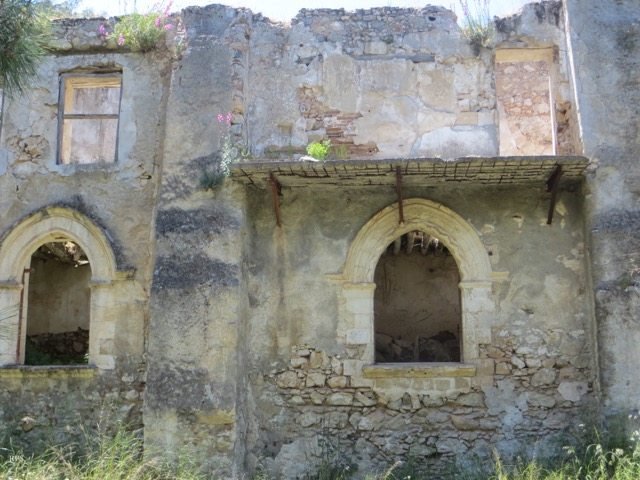The Monastery of St. Magar, or Magaravank as it is better known to Armenians, is situated high in the Kyrenia Range of North (Turkish-occupied) Cyprus. The annual pilgrimage to the monastery was suspended in 1974 when the island was invaded by Turkey, and the north of the island cut off from the south.

Magaravank, where Nicosia Armenians retreated in the heat of the summer, for idyllic picnics and long summer vacations en famille, and in groups from schools, holds a very dear, not to say sacred, place in the memories of many Armenians who lived in Cyprus before the 1974 invasion. It is remembered with a nostalgia and fondness verging on adoration.
For more than 35 years this important spiritual site for the Armenians of Cyprus, and indeed of Cilicia, remained inaccessible to them, and they were unable to maintain the monastery buildings. However, thanks to the efforts of the Armenian Prelature of Cyprus, Vartkes Mahdessian (representative of the Armenian community in the Cyprus House of Representatives), and the United Nations Peacekeeping Force in Cyprus (UNFICYP), the annual pilgrimage was revived in 2007.
This year, on May 10, I made my first pilgrimage to Magaravank, which in my imagination had taken on mythical proportions due to the stories I had heard about it over the years. Some 40 of us, including Vartkes Mahdessian and Der Momig Habeshian (pastor of Nicosia), drove up in two minibuses. The way is narrow and steep, and not suitable for large coaches. We crossed at the check-point from the South (Greek) to the North (Turkish). The Turkish border guards checked our passports and a U.N. escort arrived to follow us up to the monastery.

At first the way is through the suburbs of North Nicosia, much of it familiar to my fellow pilgrims many of whom had lived there until the invasion. “Look at that, another church turned into a mosque!” was a comment I heard a few times. “Isn’t that where your uncle/aunt/cousin lived?” was another. Soon, we were in the plains of the Mesaoria, once known as the bread basket of Cyprus and in antiquity, that of Egypt. A flat and fertile plain separated from the sea by the Pentadaktylos Mountains in the North and the Troodos Mountains in the South. The corn had been gathered in and the fields were neat and tidy, with just enough green, from olives and carobs, to make it interesting. Soon we started our climb towards Halevga (Turkish Alevkayasi) right beneath the ‘five fingers’ of the Pentadaktylos. I was dismayed to see that this beautiful slope has been scarred by huge quarries to provide materials for the unrelenting building work which is going on in the North of the island.
We drove through pine and conifer woods, up and around steep bends, to finally arrive at the entrance of the grounds of the monastery. Soldiers opened the barriers to let us through. One gets glimpses of the sea from here through the trees and the wild rhododendrons and rose bushes. Finally, we arrived and were told that we had one hour to say prayers and complete our visit.
We walked down steep steps to enter the monastery, with its courtyards, guest houses, fountain, chapel, and bell tower all in ruins, overgrown with cowslips and dog roses. The air was fragrant with pine, wild basil, wild sage, and marjoram. The beautiful old tiles on the floors were broken; possibly not one roof tile remains in place. We hurried into the chapel to hear Der Momig’s prayers and sermon, to sing “Our Father” and “Giligia,” and to light our candles.

Situated about 500 meters above sea level, the quiet and ruined monastery sits in one of the best positions in Cyprus. Nothing had prepared me for the sleeping beauty that this place has become. The building is narrower at the valley head and broadens as the valley widens. The view is stupendous, all the way across the Mediterranean to the coastline of Turkey and beyond to the Taurus Mountains. It made me catch my breath.
There have been holy people at Magaravank since the 4th century A.D. when St. Magar (or Makarios), a hermit, took up residence in one of the caves in the mountainside. Monks arrived to settle there, and the present monastery dates from around 1000 A.D. The Armenians took over in 1425, or possibly earlier. The main occupation of the Armenian monks was copying old manuscripts and writing histories, works that began under the Lusignans, during their tenure of the island. Happily the ancient manuscripts were taken to the Armenian Church in Nicosia, and to the Catholicossate of Cilicia at Antelias, Lebanon, some time ago, and have not been lost. The property, which is vast, comprising some 10,000 donums (about 5,000 acres) of fertile land, still belongs to the Armenian Prelature of Cyprus, at least nominally.
No monks have resided at Magaravank since the 1800’s, but even so, it has been considered an important religious center, serving as a resting post for pilgrims on their way to and from Jerusalem. The monastery served as a place of safety for the Catholicosate of Cilicia, when it had to leave its ancient Seat at Sis (present-day Turkey) in 1918, until it moved to its new home at Antelias. It is of note that Abbot Mekhitar of Sebastia rested at Magaravank before going on to establish the Mekhitarist Order at St. Lazarus in Venice.
Very soon, our hour was up and we were encouraged by the Turkish soldiers to say goodbye to this lovely, broken place for one more year, and return to our present lives. On the drive down the mountain, it felt as if I were waking from a deep and pleasant dream into a harsher reality.
My second pilgrimage was to the Armenian Church of Sourp Asdvadzadzin on Victoria Street, North (Turkish) Nicosia. For many years since the 1974 invasion, this sweet church and its precincts, which housed the Armenian Prelature and schools, were left in ruins and vandalized to within an inch of existence. Happily it has recently been restored by UNDP-ACT with the sponsorship of USAID, winning a 2015 Europa Nostra Award.

I remember visiting the church in 2004 and coming away saddened and repelled by the state of it: The altar vandalized and daubed with unpleasant graffiti, littered with broken bottles and human excrement. The roof broken. The gallery broken. The windows broken. Outside, the once clean and airy buildings were occupied by recently arrived mainland Turks.
Again with the help of Vartkes Mahdessian, we were able to gain access to this now spick and span compound that houses a course of the “Eastern Mediterranean University.” My fellow pilgrims this time, who graciously allowed me to tag along, were all ex-Melikian-Ouzounian Varjaran pupils—that is to say, those who had been to kindergarten and primary school in the cathedral precinct in the 1950’s.
This church is unusual in that it was not built by Armenians, but by Franks as a convent for Carthusian nuns around 1192. A number of religious orders resided there until the great earthquake of 1303, which completely destroyed the convent. It was rebuilt in the Gothic manner in 1308 and became known as the Cathedral of Notre Dame de Tyre, or Notre Dame de Tortosa, after those Orders.
Sometime around 1491, after yet another big earthquake, the cathedral became Armenian. The Ottoman conquest of Nicosia in 1570 saw it used as a salt store, before it was returned to the Armenians by a Firman in 1571, serving the Armenian community until the Cyprus troubles of 1964.
During the deportations of Armenians from Turkey in 1915-23, the cathedral served as a sort of refugee center, with some families taking up temporary residence under its arches for lack of other accommodations. Later a monument was built to the Armenian Genocide. The precincts were used as barracks for the Turkish Cypriot militia and Turkish soldiers until an earthquake in 1998, when they were abandoned by the military.

Today it is a lovely space—an oasis among the dilapidated buildings of North Nicosia, clean and cool. We were let in by a Turkish soldier who stayed with us the entire time and was rather fascinated to hear the stories and reminiscences of the former Melikians, many of whom spoke fluent Turkish, having lived in what was the Armenian Quarter in the mainly Turkish area of Nicosia. The school buildings are pristine, the fountain clean, the Grecian column of the Genocide Monument still in its place, albeit broken and without its plaque or cross. It is a pity that the Melikian Mansion, which is believed to be the original monastery building and was home to the Armenian Prelature until the late 18th century, is completely derelict and in danger of falling down.
On Sun., May 11, 2013, the first Holy Liturgy since 1964 was heard, and the church re-consecrated. On Sun., Nov. 30, 2014, the new Catholicossal Vicar, His Eminence Archbishop Nareg, presided over the second Holy Liturgy. Mass is now celebrated at the Armenian Church of Sourp Asdvadzadzin once every three months. Should you find yourself in Nicosia on one of those days, be sure to go and be part of the history of this important building.
R.P. Sevadjian is the author of In the Shadow of the Sultan, a historical coming of age novel set during the Hamidian Massacres of 1896. Her book is available from amazon.co.uk.


Very moving account. God Bless the Armenians who kept these places in their hearts and refused to let go.
Also interesting that access was allowed at all by the Turkish/ Turkish Cypriot authorities. Why?
What has happened in the last few years to allow Christians to again visit these places.?
Very educational and interesting articles about historical events and geographical locations of Armenian interests about which I had no prior knowledge of. Thank you for providing us with such articles . Love